It is practically impossible to buy a pear of a variety of the old domestic selection Severyanka now. Nurseries stopped breeding her. However, Severyanka is still often found in private courtyards in the Urals. The variety is loved by many gardeners because of the delicious fruits, so many lovers propagate it by grafting. The Severyanka pear was bred by crossing two varieties: Clapp’s Favorite and Koperechka.
Characteristic of the variety
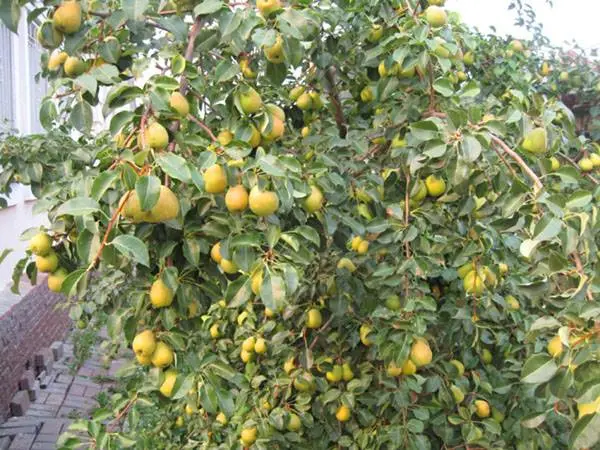
The fruit tree is characterized by a high height of up to 5–6 m. However, a pear grows to such dimensions at the age of 14 years. The young tree has an average height, but the crown is initially wide. Severyanka branches have intensive growth. As a result, the pear forms a pyramidal, almost rounded crown up to 6 m wide. The branches grow powerful, but do not create thickening. The bark is smooth grey. Young shoots are distinguished by a green color with an edge present at the tips of the branches. Foliage color is dark green. The shape is oval-elongated with a sharp top. The leaves are slightly curved inward, and have small notches along the edges.
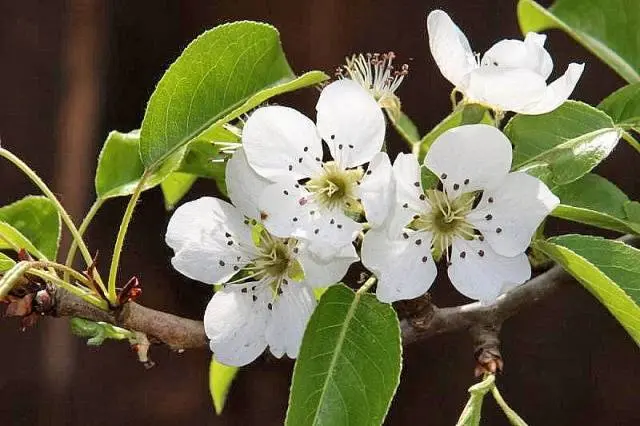
The petals of the flowers are white, not completely closed with each other. The edges are semicircular without notches. The shape of the Severyanka flower is similar to a small saucer. In the inflorescence they appear from four to six pieces.
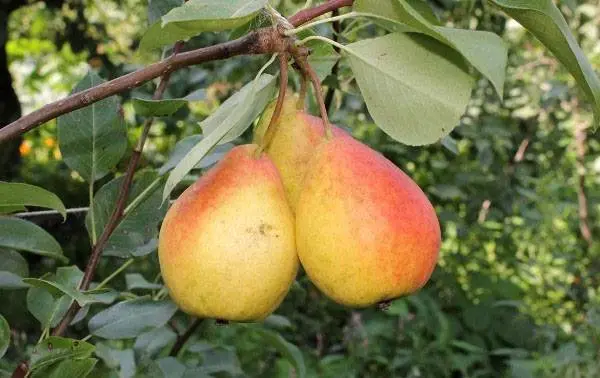
Many lovers are looking for a description of the Severyanka pear variety, photos, reviews for the sake of describing the fruit. They can be described as red-cheeked beauties. The fruits of Severyanka grow in different sizes. Most pears weigh about 85 g, but there are larger specimens weighing up to 120 g. The shape of the fruit is conical with a truncated tip. The technical maturity of a pear is determined by the yellow-green color of the skin. Moreover, the yellow color is present on a smaller part of the surface of the fetus and looks like a slight tan. On the skin of a fully ripe pear, ready to eat, there are few green glimpses, and yellow color dominates more. The barrel of the fruit is covered with a pink blush. From here came the second name of the variety – Severyanka red-cheeked.
At any stage of fruit maturity, the skin always remains matte and never becomes glossy. It is quite thick, but roughness is not felt when eaten. The stalks are quite long, often curved. The core of the fruit has a bulbous shape. Inside are small seed chambers, but with large grains. Ripe seeds turn brown.

The frequently asked question, what does the Severyanka pear taste like, can be answered as follows:
- the pulp of the fruit is crispy, with a high content of juice;
- the taste resembles wine sweetness with the presence of acid and the absence of astringency;
- aroma is weak;
- the color of the pulp is cream.
As a percentage, the amount of sugar in a pear is 11,8, and acid is 0,38. By destination, the pear variety Severyanka Krasnoshchekaya is considered universal. Harvest time falls at the beginning of the second decade of August. Fruits are stored in the cellar for no more than 10-15 days. After this time, the flesh becomes looser and acquires a brown tint.
The fruits are quite strong on the stalks and are not afraid of strong winds. However, this only lasts until the pears are fully ripe. After the fruits ripen, they will fall off the tree together in three days. Pears harvested from the ground will not be stored. In order to avoid crop loss, it is recommended to start harvesting about five days before the fruit is fully ripe.
Considering the description of the Severyanka pear variety, it is worth noting the high yield, as well as precocity. Already in the fourth year after planting a seedling, you can get the first fruits. Further, the yield will grow rapidly. A pear in its seventh year of life can bring up to 20 kg of fruit. The yield of an adult tree ranges from 40–60 kg. But this is not the limit. In a fruitful year, a pear can produce up to 110 kg of fruit.
The variety is considered partially self-fertile. To get a good harvest, the Severyanka pear still needs pollinators. They may be other varieties that have the same flowering period. In the case of self-pollination, an adult tree will give a maximum of 35% of its crop.

In terms of winter hardiness, the Severyanka red-cheeked pear surpasses many varieties. The freezing of two trees was recorded in Ufa. The winter of 1978 was distinguished by severe frosts down to -50оC. At a temperature of -42оWith observed complete freezing of the crown, but the root system was unaffected. Pears started up new shoots and fully recovered.
The Severyanka pear variety tolerates drought moderately, but it is better not to bring the tree to such a state. If artificial irrigation is not provided in a dry year, the ripening of the crop will be delayed. The fruits will gain little juice, will be small and lose their taste.
A positive feature of the variety is resistance to common pests: codling moth and pear mite. However, late frosts can freeze the leaves. In this case, the risk of bacterial diseases increases.
The video provides an overview of the Severyanka red-cheeked:
Pear cultivation and tree care

For the Severyanka pear, planting and care involves almost the same steps performed for other varieties. Nurseries probably no longer sell seedlings, but they can be found on the market from private traders. Fans who have preserved this variety breed it by grafting. If you managed to buy a seedling of Severyanka, then you immediately need to choose a suitable place for the tree:
- The tree loves loamy or sandy soil. Before planting in the ground, you need to add a large amount of humus.
- Pear does not like ground water. If the layers are located above 2 m, then the root system of an adult tree will get wet.
- The northerner loves sunlight and does not tolerate wind blowing.
Landing time falls on April or the end of September, the beginning of October. It all depends on the climatic conditions of the region. If severe frosts are observed in winter, then it is better to plant a pear seedling in the spring. Until autumn, the tree will have time to take root and not freeze. A place for a seedling is prepared at least a week in advance. First, they dig a hole 80×100 cm in size. Two buckets of humus mixed with a bucket of fertile soil are poured onto the bottom. 200 g of fertilizer containing potassium are added to this mixture, as well as superphosphate – no more than 800 g.
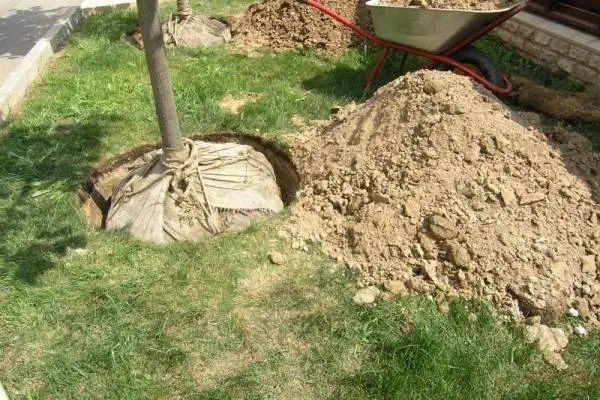
After acquiring a pear seedling, they begin to plant it:
- First, a liquid solution is made from clay – a talker. The roots of the seedling are dipped into it.
- The next step is to inspect the crown. Long branches are shortened, and damaged ones are completely cut off.
- The seedling is dipped into a hole with its roots, a peg is driven in nearby and a tree is loosely tied to it.
- The root system is lightly sprinkled with soil, after which it is plentifully watered. When the water is absorbed, the soil will settle a little. The pit must be completely covered with earth, and the seedling should be tied more tightly to the peg.
When the pear is well rooted, the support can be removed.
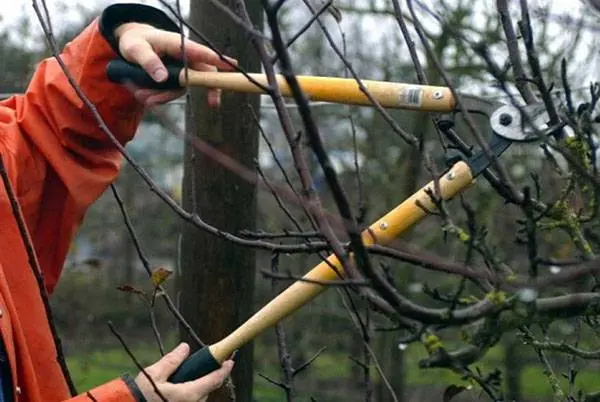
The main action during care is considered to be pruning of the Severyanka pear, and this should be done from the first days of the seedling’s life. If the tree was purchased without skeletal branches, then the stem must be shortened with a pruner so that a twig 90 cm high remains above the ground. If there are skeletal branches on the seedling, they are incompletely pruned. Leave twigs with three buds. Such actions are carried out for three years in a row. Further pear pruning is considered sanitary. Dry, frozen and damaged branches are removed from the tree. Be sure to cut off the shoots.
Pear care involves periodic loosening of the soil around the trunk. This is necessary for access to the roots of oxygen. It is advisable to get rid of weeds immediately. They draw moisture and nutrients from the soil. Severyanka is quite a moisture-loving variety. The pear needs to be watered more often so that the soil does not dry out, but waterlogging should not be allowed. Once a season, the tree is fed with minerals. In autumn, humus is introduced under the root. Before winter, it is important to water the pear abundantly and mulch the soil. This procedure increases the chance of overwintering the tree.
Grade Reviews
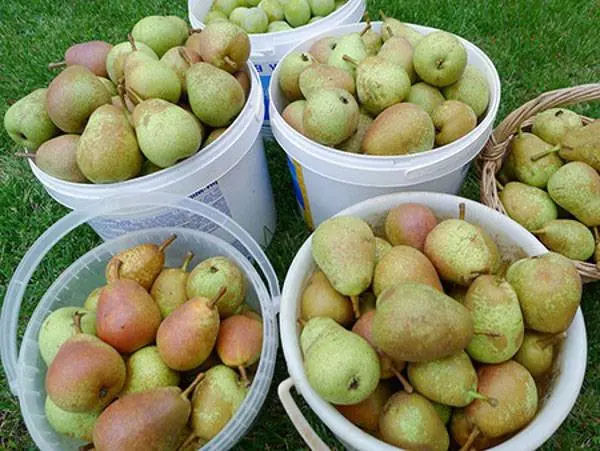
On an industrial scale, Severyanka is not currently used, but gardeners love this variety, as evidenced by numerous reviews. Most often, people write that the old selection is much better. The trees are more hardy, resistant to pests and produce tastier fruits than modern varieties.









